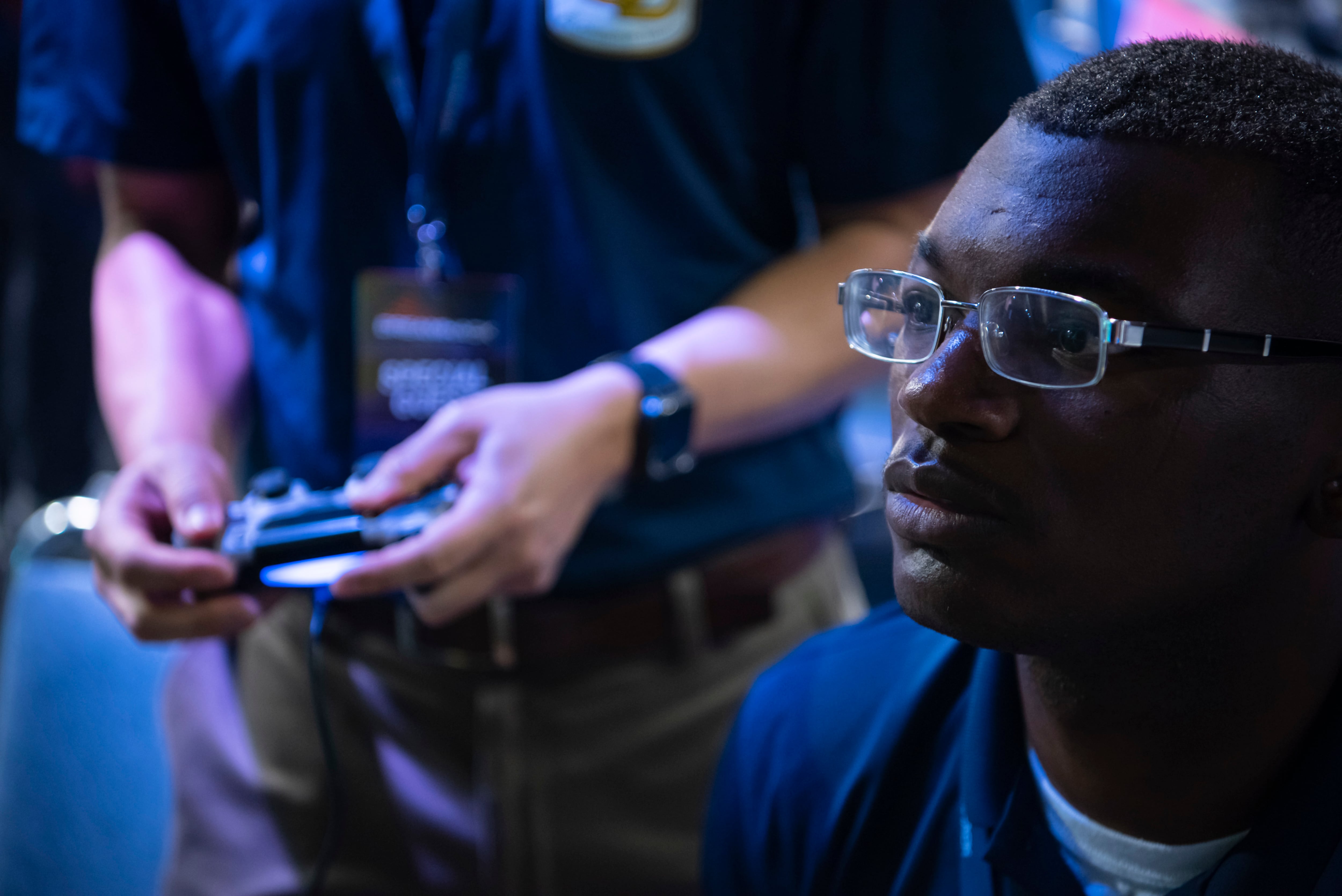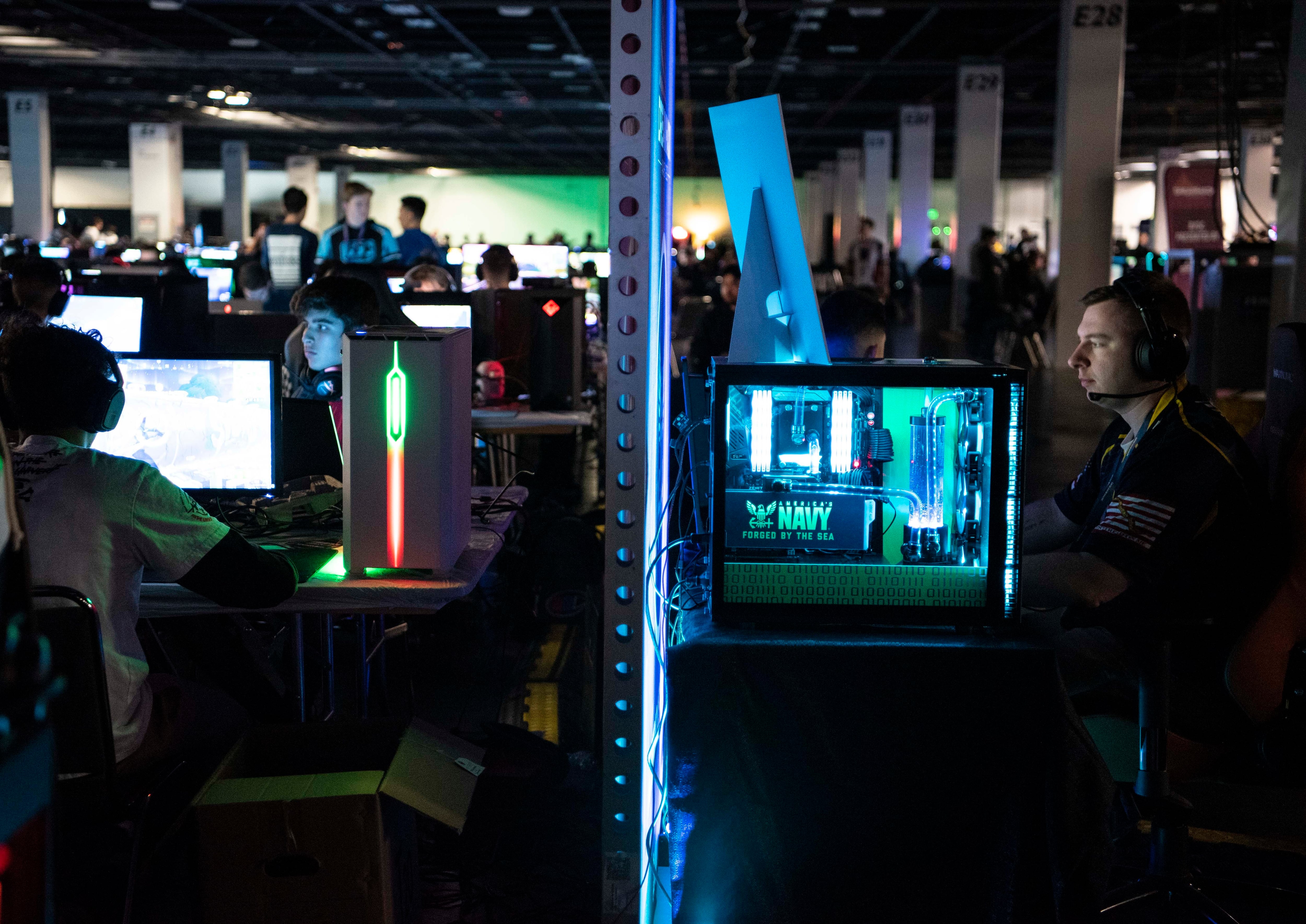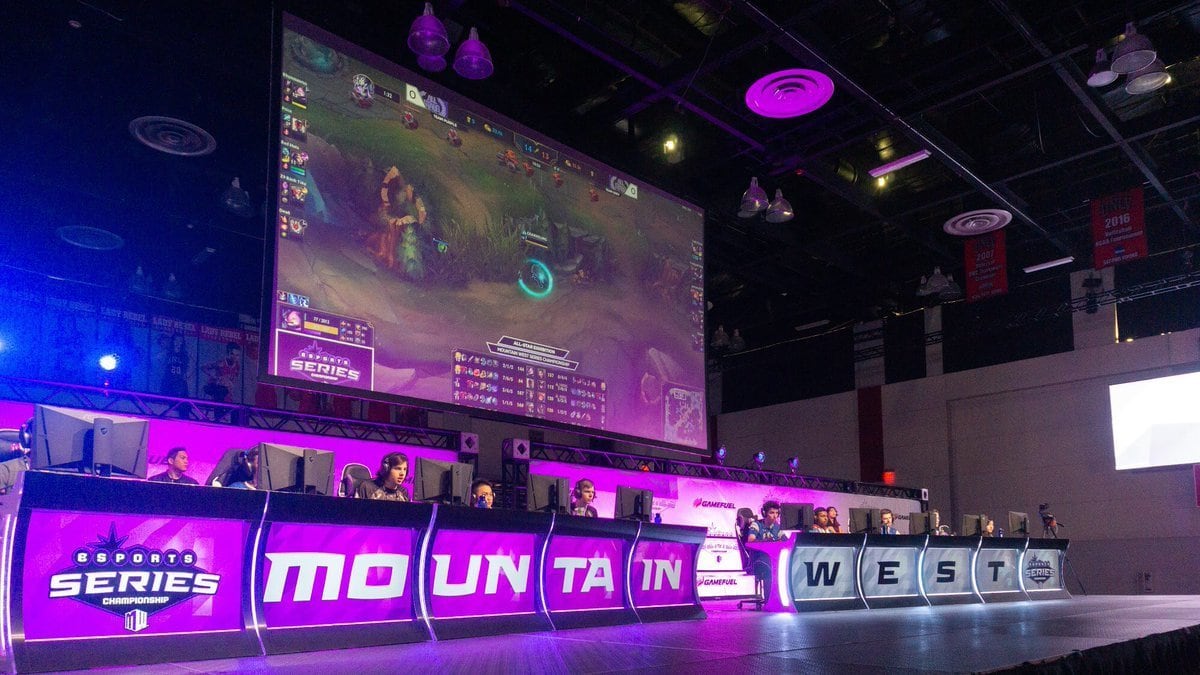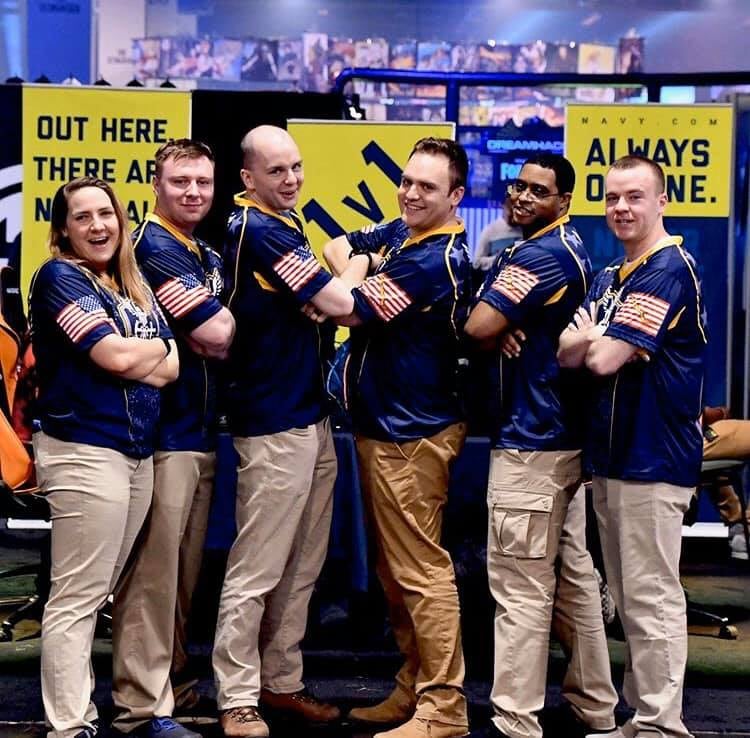The Navy squad jumped from the flying blue battle bus and landed in a chaotic scene already unfolding on the island below.
Lt. Aaron Jones’ avatar, “Viktorous,” ran inside a barn and thrashed his way through hay bales with a machete, grabbing guns and ammo along the way.
“I need a gun,” Personnel Specialist 1st Class Keith Cherry, 34, called out over the squad’s headsets.
His avatar, “KillswitchReborn,” was already taking fire.
“I’m on my way now,” Jones said as his avatar pulled a firearm from a backpack and made his way outside.
A fellow shipmate on the Goats and Glory team announced his first kill as the squad of four players made their way through fields at Frenzy Farm, one of several locations in the multi-player online video game Fortnite Battle Royale.
Tensions spiked as the battle moved to the farmhouse’s roof. Navy teammates exchanged gun fire with their enemies.
In less than four minutes, only Viktorous remained alive. That wouldn’t last. Jones’ avatar was shot once. And as he crawled into an attic, the online combatant followed.
“Oh, he just got me,” Jones, 28, announced.
Fortnite’s fantasy landscape might not have been the Navy Esports team’s forte during a demo by a few inaugural members in early February but winning in the competitive online realm isn’t necessarily the main goal.
The sea service sees Goats and Glory as a tool to recruit from a group of young people that grew up online and are more used to streaming content than they are watching traditional broadcast programming. The Navy plans to tap from its own talent pool of gamer-sailors to reach them.
Gone is the stereotype of gamers as unfit, underemployed slackers — mostly young men who hang out in their parents’ basements.
It’s a social environment. The gamers who inhabit it can gain valuable skills in building teams, resolving conflicts, communicating and strategy, the sorts of habits that can be applied to making warfighters, Mark Deppe — director of the Esports program at the University of California at Irvine — told Navy Times.
“All those things are things that employers and the military are probably really interested in,” Deppe said.

Technology consulting firm Activate estimates that global viewership for Esports will reach 700 million by 2023. A quarter of Esports followers in the U.S. are aged 18 to 24, Activate said in its 2020 media and technology outlook. Just 7 percent of people in that age group follow the National Football League.
Esports is big business with many entities wanting a piece of the action, and the Navy announced its intentions to join the cyber fray with a Feb. 26 message.
It’s part of the Navy’s “big picture marketing strategy,” Capt. Matt Boren, chief marketing officer for Navy Recruiting Command told Navy Times.
“We’re always there and we want to be where our audience is,” Boren said. “One thing the military really tries to do is show that we’re relatable. We want to show that the military is relatable to our target audience, which is predominantly 17 to 24-year-olds and that these relatable people do relatable things.”
That can help to combat “misconceptions” among possible recruits, Boren said, including those who “think they couldn’t fit to serve, or the Navy’s not right for them.”
“We can show them how it might be aligned to provide training opportunities and even a career.”
The Navy’s inaugural Esports team is comprised of players drafted from the sea service’s roster of recruiters. During the next few months, the team, whose members are spread out across the country, will fill roles as ambassadors and travel to gaming competitions and conventions to gain visibility. In the meantime, the service will build a new 10-person team from across the fleet.
Those new team members will train to work as recruiters at the Navy Recruiting Command in Millington, Tennessee. From there, they will operate out of a specialized facility for gaming, so the team can stream content and develop followers on platforms like Twitch, an online channel that allows people to livestream their games while others tune in, watch and chat.
A handful of sailors will remain with their commands and work as team alternates.
The squad will travel and compete at conventions, attend Navy Week events nationwide and work with high schools, many of which already have their own Esports teams, Boren said.

The sea service’s new group of gamers is the latest entry from an all-volunteer force that’s trying to reach young players where they are.
The Army started its Esports team in 2018 after leaders realized its traditional recruiting approach wasn’t working as well as it previously had, Lisa Ferguson, a spokesperson for the Army’s Recruiting Command, told Navy Times.
Ferguson said about 70 percent of people aged 21 to 30 spend as many as nine hours a day playing or watching video games, while half of today’s youth admitted knowing little about military service.
The Army’s Esports team has attended various conventions as well as the first Call of Duty Endowment Bowl, Ferguson said.
The ground service’s roster has several sub-teams, including a Warhammer 40,000 Team, where players engage each other on a tabletop war game. They use miniature models of warriors and combat equipment on top of a battlefield layout.
The Army doesn’t track its leads all the way to contracts. But its Esports team collected more than 3,500 leads in fiscal 2019, and more than 8,500 in the first four months of the federal fiscal year that began on Oct. 1.
Ferguson mentioned one prospect who played with the team at a convention in March 2019. That player had a scholarship from a college Esports team and continued to game online with Army team members.
When that player lost his scholarship and decided to leave college, Army gamers re-engaged with him through Discord, a text app for gamers, and connected him with a recruiter.
He shipped to basic training in February, Ferguson said.
And Army’s Esports recruiting team isn’t alone. The U.S. Military Academy at West Point announced in January that an Esports team of cadets had been recognized at the club level. The U.S. Air Force Academy already has a team, too.
U.S. Naval Academy spokeswoman Maddie Darbie told Navy Times that Annapolis doesn’t have an Esports club team and the idea hasn’t been floated, but it might be only a matter of time.
Michael Brooks, executive director of the Kansas City, Missouri-based based National Association of Collegiate Esports, has witnessed a lot of growth since the association launched in 2016 with six members.
It’s now more than 200. The association governs varsity collegiate Esports teams, much like the National Collegiate Athletic Association regulates student athletes. Though the association has not worked with the military, each of the branches have been in touch about joining events, he said.
“Esports at the varsity level is exactly the same except for they’re not competing on the field or the court anymore,” Brooks told Navy Times. “They’re competing in an Esports lab and they’re competing online against other institutions where their students are doing the same exact thing so that the competition is remote now. It’s online. It’s not in person but the idea is very much the same.”
Brooks sees parallels between the embrace of Esports by universities and the military. First is the obvious value as a recruitment and retention tool. There’s also an academic connection with some universities now offering classes in Esports because of its links to business and software development.

The Navy has partnered with Twitch, ESL and DBLTAP to help promote its initiatives, Cmdr. Dave Hecht, a spokesperson for the Chief of Naval Personnel, told Navy Times.
According to information provided by Hecht, the sea service will spend $34 million of its $64.9 million marketing and advertising budget on digital media in 2020.
None of that money will go to broadcast television.
Contrast that with 2019, when the Navy spent $3.4 million on TV and $17.9 million on digital media out of an entire marketing and advertising budget of $48.7 million.
A year earlier, the Navy spent $22 million on television and $28.5 million on digital from a $71.8 million marketing and advertising budget.
Capt. Boren said going digital allows the Navy to maximize coverage while overcoming geographic boundaries. As a recruiting method, it’s one more way for the service to lean on its experts, much like the Leap Frogs or the Blue Angels.
“I call it no blind spots,” Boren said. “We’ll be able to better connect with America’s youth to help talk to them about opportunities in the Navy.”
A career naval flight officer for the E-2D Advanced Hawkeye, Lt. Jones is serving as an instructor at Navy Orientation Recruiting Command in Pensacola. Though he hasn’t attracted any recruits by gaming yet, he streams from his personal Twitch channel for three hours nightly and four hours on Saturday mornings. Video games are a “passion” that allow Jones to communicate with others, including friends he’s made through the platform.
“I think it’s more of a way to interact with people and show them, ‘The Navy, we play video games, we’re exactly the same. We love the same things,’” Jones said.
As far as his pitch when talking to high schoolers, the Navy “sells itself,” he said
“The first thing they ask is, ‘How long have you been in and what do you do?’” Jones said, trailing off as he continued to play Fortnite. “After they ask me that, usually I tell them I’ve had the pleasure of flying in the back of a Hawkeye. I’ve got to launch off a carrier. I’ve got 100 traps and takeoffs on a carrier. The Navy has been amazing.”
Personnel Specialist 1st Class Cherry, who is assigned to Navy Recruiting District Atlanta, said he’s been mentoring a young player from Georgia that he met online while training for Esports.
“He’s getting ready to graduate high school and looking for something better to do in the future,” Cherry said. “So, we started talking about the Navy.”
Cherry enlisted in the Navy 15 years ago, and began playing Esports heavily around 2015 to unwind and pass the time. He said he’s found a sense of community through playing that makes him feel connected to “something bigger.” His encounter with the soon-to-be high school graduate was happenstance, he said.
“It happens to me a lot more often than you’d think,” he said. “I’ll come across somebody on a gaming community page and like, ‘Hey, can I get some training in with you?’ We’ll sit down and we’ll train and it just starts the conversation because, when I train with people, and I mentor them, I like to have that one-on-one time and get to know them as a person so that it’s more relatable and they feel a little more comfortable accepting the information that I’m giving them.
“Once you start to talk to people and get to know them on that personal level, they start to ask questions. ‘Well, how old are you? What do you do and how did you get into it? Where do you intend to go from there? And that’s kind of how I met this young gentleman.”

Aviation Maintenance Administration 1st Class Heather Roche, 28, is a member of the Navy’s inaugural team while assigned to a recruiting command in Washington. She’s new to streaming on Twitch but she’s not new to gaming. She grew up playing video games and now uses them to keep up with Navy buddies scattered across the planet.
The gaming world is dominated by young men but she’s been welcomed by the younger generation.
“The community is teaching me all kinds of things,” Roche said. “I feel really at home.”
The Navy’s window to apply to join the Esports team is March 15 through May 1. To be eligible, you must be a third class petty officer or above and have passed three years of physical fitness assessments.
The 10-sailor team will focus its competitive play on the multiplayer first-person shooter game Counter-Strike: Global Offensive and will be trained by the Seattle-based Esports team Evil Geniuses, Hecht said.
A six-part series documenting their training will appear on multiple digital platforms, and a special Navy Twitch channel is slated to be launched later this spring. The team is also expected to appear at TwitchCon in San Diego, California in late September.
Boren is bracing for thousands of applicants. Expect fierce competition.
“The first thing, we’ll do the talent search to see how competitive they are,” Boren said.
Next, they’ll be screened to see if they have the right personality to excel as recruiters.
“They’re going to be, you know, the face of the Navy in a lot of places,” Boren said. “We want to make sure they’re qualified, not just as a gamer but as a representative of the Navy, who, you know, could be in very high profile situations.”
Courtney Mabeus-Brown is the senior reporter at Air Force Times. She is an award-winning journalist who previously covered the military for Navy Times and The Virginian-Pilot in Norfolk, Va., where she first set foot on an aircraft carrier. Her work has also appeared in The New York Times, The Washington Post, Foreign Policy and more.





